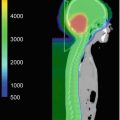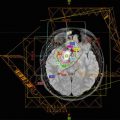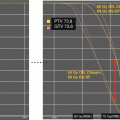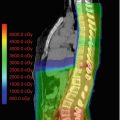Author technique year
Median PFS post RT2
Median OS post RT2
Median PFS No RT2
Median OS No RT2
Merchant FFRT 2008
NA
67% at 5 years
NA
NA
Merchant CSI 2008
53% at 4 years
NA
NA
NA
Merchant SRS 2008
NA
20% at 5 years
NA
NA
Bouffet 2012
3.3 years
4.5 years
6 months
11 months
Zacharoulis 2010
18 months
51 months
8 months
22 months
Stafford SRS 2000
18 months
40.8 months
NA
NA
Kano SRS 2010
41.6% at 3 years
23% at 3 years
NA
NA
Hoffman SRS 2014
40.8 months
71% at 2 years
NA
NA
Mohindra PDR 2013
35.7% at 4 years
60% at 4 years
NA
NA
There have been several recent publications on this issue (Table 29.1). In one of the largest papers on reirradiation for recurrent ependymoma, Merchant and colleagues retrospectively reviewed the outcome of 38 children with relapsed ependymoma, who underwent a second course of radiotherapy either in the form of stereotactic radiotherapy (SRS), craniospinal irradiation (CSI), or focal fractionated reirradiation (FFRT) (Merchant et al. 2008). There was no uniform policy as to who underwent reirradiation or other alternative salvage therapies over the time of this review. All children in this series were managed for localized disease at initial presentation. Thirty-six patients received a median dose of 50.4 Gy (range, 37.8–60.4 Gy) with conventional fractionation for their initial course of radiotherapy (RT1). Two patients had hyper-fractionation schedules initially. Only one had CSI at diagnosis. Thirteen patients with local failure were treated by using FFRT to a median dose of 52.2 Gy (range, 50.4–54 Gy). Median combined total dose was 111.6 Gy (range, 98.4–120 Gy) and the median time from initiation of RT1 to RT2 was 23 months (range, 10–82 months). With a median follow-up of 30 months (range, 2–136 months) after RT2, 10 of the 13 were alive and disease free. Three patients died from metastatic disease within 20 months of RT2. Nineteen patients with a mix of local and metastatic disease had CSI and focal boost after attempted resection of all disease. Three patients with local failure only received CSI for salvage therapy, one of whom experienced relapse with metastatic disease after 6 months despite CSI dose of 39.6 Gy. Nine of 12 patients with metastatic disease were disease free at a median follow-up of 22 months (range, 3–69 months). Despite three recurrences, none of the 12 patients with metastatic disease had died in the follow-up period. Of the four patients who had both local and metastatic recurrence, only one survived and was still alive 20 years after reirradiation. Symptomatic cerebellar necrosis was noted in one patient in an area that received a total of 99 Gy. This patient had the shortest interval between RT1 and RT2 of 4 months. Another patient developed myelopathy and changes on imaging in the cervical spine in an area that had had surgery and 54 Gy and another patient developed a second high grade glial neoplasm in an area that received 59.4 Gy. Six patients were treated with radiosurgery using a median dose of 18 Gy (range, 15–20 Gy) with five patients receiving treatment within the prior high dose region and four patients had surgical resection prior to SRS. The median time from initiation of RT1 to RT2 was 21.9 months (range, 7.5–67.7 months). Four patients relapsed within 18 months and died of disease. Two progressed with local failure only and two had combined local and distant failure and all four patients had neuroimaging or pathologic evidence of necrosis. Another patient died of radiation necrosis at 40 months, and the last patient required surgery and hyperbaric oxygen for necrosis but was disease free 10 years post treatment. This paper gives reasonable evidence to support reirradiation in ependymoma but toxicity, especially for SRS, remains an issue. In addition, despite toxicity, local control was not optimal in the SRS group.
Bouffet and colleagues reported their experience with reirradiation in recurrent ependymomas in 2012 (Bouffet et al. 2012). This paper is unique as it reports not only survival and toxicity data but also quality of life and molecular markers. Eighteen patients were reirradiated, 2 with SRS, 12 with FFRT, and 4 with CSI due to disseminated recurrence. The median time from RT1 to RT2 was 2.2 years. Of those who received FFRT, the retreatment median dose was 54 Gy (range, 45–59.4 Gy) with total cumulative doses between 108 and 113.4 Gy. Reirradiation was well tolerated overall but toxicity was noted in one patient who received SRS to the primary lesion. This patient had both clinical and imaging evidence of radiation necrosis associated with significant neurological decline. Similar to Merchant’s findings, all four patients who underwent CSI due to metastatic disease were alive at a median follow-up of 1.9 years (range, 0.6–4.7 years). A notable finding which was also suggested in some other studies (Merchant et al. 2008; Lawrence et al. 2010; Hoffman et al. 2014) was that the time to progression after reirradiation was significantly longer than the time to initial recurrence/progression (3-year PFS was 61% after reirradiation vs. 25% after first course or radiation). In order to investigate this further, the authors examined the role of γH2AX as a marker of radiation-induced DNA damage. Positive γH2AX expression at the time of resection before reirradiation predicted longer time to progression in reirradiated patients (p 0.002). All tumors that were negative for γH2AX recurred within the first 2 years suggesting radioresistance. Such markers may become increasingly important when selecting appropriate patients for reirradiation in the future. Three-year overall survival was 7% ± 6% in 29 patients that were treated with surgery and/or chemotherapy at recurrence and 81% ± 12% for 18 patients who were treated with reirradiation in addition to surgery and/or chemotherapy at recurrence. It is important to note that the cohort of 18 patients who were reirradiated represented a consecutive series of recurrent patients after it was decided to reirradiate all patients with recurrent ependymomas that likely minimizes possible selection bias.
In 2009, Liu published a small series of six patients who were reirradiated with 24–30 Gy in 8–10 Gy fractions via external beam RT and all were alive at a median follow-up at 28 months (Liu et al. 2009). However three patients developed radionecrosis, two of which were symptomatic. That same year outcome data from the UK reported reirradiation in 14 children of whom 9 had focal fractionated radiotherapy, three had stereotactic single-fraction or hypo-fractionated RT and two had craniospinal RT (Messahel et al. 2009). The authors noted that older children who received craniospinal radiotherapy (n = 10, including those who were radiation naïve) at relapse had a better outcome than those who received either focal radiotherapy or none at all.
SRS is attractive in the reirradiation setting as it minimizes the amount of normal tissue treated, hence potentially reducing late effects such as IQ changes and also means less time spent having treatment versus a repeat 5 or 6 week course of radiotherapy. However, the studies described above indicate that the risk of radionecrosis may be unacceptably high. A number of studies have specifically looked at outcomes following SRS for relapsed ependymoma. Stafford published the outcomes of 11 patients previously treated to a median of 54 Gy followed by gamma knife SRS to 18 Gy (Stafford et al. 2000). There were two cases of radionecrosis, one in a patient who had received 24 Gy and another in a patient who had two SRS in abutting locations treated to 18 and 12 Gy. Local control was achieved in 82% of sites and the estimated 3-year rate of local control was 68%. Distant failure occurred in two patients. Kano reported a median survival of 27.6 months after SRS median dose of 15 Gy in 21 patients, 36.7 months after 52.2 Gy EBRT. Necrosis was identified on imaging in two patients, one of whom was symptomatic. The interval between EBRT and SRS in these two patients was 22 and 37 months. Distant intracranial or spinal relapse after RT and SRS occurred in ten patients. On univariate analysis factors associated with distant tumor relapse included patients with spinal metastases before RT (p = 0.037), a tumor located in the fourth ventricle (p = 0.002), and an interval <18 months between RT and SRS (p = 0.015) (Kano et al. 2010). In a review of 12 patients who were treated with SRS (24–30 Gy) over 3–5 fractions after 55.8 Gy of EBRT, Hoffman reported a 3-year local control rate of 89% (Hoffman et al. 2014). The median time from RT1 to RT2 was 25 months. Six patients showed radiological changes consistent with radiation necrosis at a median of 5 months including one patient who received SRS outside the RT1 radiation field. Five patients were symptomatic and three received treatment with bevacizumab. It seems that the benefit of the high doses per fraction comes with a price in the reirradiation setting. Mohindra et al. took a different approach in an older group of ependymoma patients who were median age 25 at reirradiation and median age 10 at RT1 (Mohindra et al. 2013). They utilized pulsed dose radiotherapy (PDR) which uses a low dose rate of 6 cGy/min, in comparison to 400–600 cGy/min for conventional delivered radiotherapy, which should allow for enhanced normal tissue repair. The median interval between two radiation courses was 58 months (range, 32–212 months) with a median of 48.4 Gy delivered conventionally in RT1 and a median cumulative radiation dose per site of 105.2 Gy (range, 90–162.4 Gy). Half of the lesions were controlled at last follow-up. None of the patients developed necrosis on serial magnetic resonance imaging scans, but one patient had progressive radiculopathy which was treated with hyperbaric oxygen. This study had only five patients with low RT1 doses and very long intervals between RT courses in an older population. Additionally, lowering the dose rate means prolonging the individual fraction time that may not be acceptable for younger patients. It is difficult to draw conclusions from this study but it does provide some food for thought on an alternative treatment regime.
All papers mentioned the benefit of maximally safe resection in this disease and most included metastasectomy where possible. The studies consistently report a survival benefit with reirradiation and fractionation seems to be the less toxic approach in terms of radionecrosis. The appropriate retreatment volume is debatable as distant relapses occur even with local control and so the option of reirradiating with CSI and boost should be considered on an individual basis. There is some evidence that those treated with CSI at relapse do well.
29.2.2 Medulloblastoma
Historically, relapsed medulloblastoma (MB) has a median survival of approximately 12 months (Packer and Finlay 1996). Several recent publications discuss their experience on reirradiation in recurrent medulloblastoma (Table 29.2). More recently, Wetmore published results on 38 relapsed medulloblastoma patients, 14 of whom were reirradiated and concluded that the use of reirradiation as a component of salvage therapy may prolong survival (Wetmore et al. 2014). Until 2003, the initial radiation dose for standard risk (SR) patients was CSI (23.4 Gy), posterior fossa RT (36 Gy), and primary-site RT (55.8 Gy) using a 2-cm clinical target volume (CTV) margin. After 2003, SR patients received CSI (23.4 Gy) and primary-site RT (55.8 Gy) using a 1-cm CTV. High-risk (HR) patients received CSI (36–39.6 Gy) followed by primary-site RT (55.8 Gy) using a 2-cm (pre-2003) or 1-cm (post-2003) CTV margin. There was a 39-month median interval between RT1 and RT2. Those who were reirradiated included 11 originally SR patients and three originally HR patients. Eight of these 11 patients received CSI and “boost” to the primary site of recurrence, two patients received only spinal re-RT (site of disease recurrence), and one patient received a second course of focal RT to the site of recurrence in the posterior fossa. None of the HR patients were reirradiated with CSI. Overall the median retreatment dose was 36 Gy (18–54 Gy) with a total cumulative dose of 91.9 Gy (73.8–109.8 Gy). Six SR patients had tumor progression after receiving re-RT (CSI and boost) and five of these had tumor recurrence within the volume of CSI but outside the boost area. One patient had disease recurrence both inside and outside the retreated volume. This paper reported a statistically significantly higher rate of radionecrosis in those who were reirradiated in comparison to those who were not (64% vs. 29%). The cumulative doses received in those with necrosis were not detailed. However, the necrosis was asymptomatic and did not require intervention. There was also a higher rate of hypopituitarism and hypothyroidism noted in the reirradiated group but this did not reach statistical significance. In addition, one patient had treatment stopped early due to cerebral edema. Bakst reported outcomes on 13 patients who were reirradiated for medulloblastoma, 11 of whom completed the therapy with a median follow-up of 30 months (range, 0–176 months) post RT2 (Bakst et al. 2011). Median time from RT1 to RT2 was 57 months (range, 25–112 months) and reirradiation always followed chemotherapy and surgery. The median initial CSI dose was 36 Gy (18–36 Gy) with boost to tumor of 54 Gy (50–59.5 Gy). The median reirradiation dose was 30 Gy (range, 19.8–45 Gy), with a median fraction size of 1.5 Gy (range, 1.0–1.8 Gy). Median cumulative maximum dose to the brain or spine was 84 Gy (range, 65–98.4 Gy). Only one patient received CSI for RT2 to a max cumulative dose of 66 Gy. There were six failures at a median of 17 months (range, 2–59 months), of which five were in patients with gross disease at time of reirradiation. Failures occurred both in and out of the RT field. Two patients underwent further surgery followed by a second course of reirradiation to 30 Gy to the posterior fossa with a cumulative combined dose of 115.8 Gy and 110 Gy. Reirradiation was well tolerated with one case of asymptomatic in field radiation necrosis at 39 months. Other toxicity included significant hearing loss in 38% but this may have been multifactorial and also 15% of patients developed hypopituitarism. Neurocognitive impairment was noted in one patient.
Table 29.2
Reported outcomes in reirradiated medulloblastoma
Author (number of cases) | Median PFS | Median OS |
|---|---|---|
Wetmore (14) | 5 years 55%, 10 years 33% from original diagnosis with re-RT at relapse | |
5 years 46%, 10 years 0% from original diagnosis with no re-RT at relapse | ||
Baskt (13)
Stay updated, free articles. Join our Telegram channel
Full access? Get Clinical Tree
 Get Clinical Tree app for offline access
Get Clinical Tree app for offline access

|




